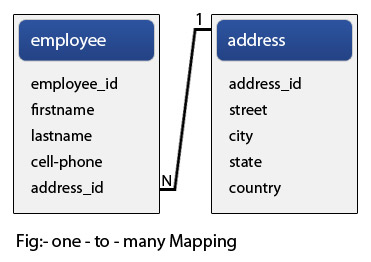Hibernate One to many XML Mapping <bag> example
In this section, you will learn how to use <bag> element instead of <set> or <list> element in mapping XML file in Hibernate.
EXAMPLE
Table Mapping
In the below figure , the address_id is the foreign key to the table employee. With the help of address_id , we are here doing one to many mapping. The logic behind using this mapping in below example is - many employees can have the same street, city, state ,country as address. Only the house number differentiate the two people addresses. So address_id in employee table can have many same address ids which indicates to the same address in the address table.

In this example, we are inserting data into two table simultaneously which are correlated to each other. Here address table holding the data of the unique addresses, each having an unique id. This unique id is used to connect the address to the employee table's address id. This indicates the address of the employee. In conclusion, many employee can have the same address (except house/flat numbers). For example : Two people may have address- Salt Lake, Kolkata, West Bengal, India.
The project hierarchy and jar file used is given below :

CODE
hibernate.cfg.xml( /src/hibernate.cfg.xml )
<?xml version='1.0' encoding='utf-8'?> <!DOCTYPE hibernate-configuration PUBLIC "-//Hibernate/Hibernate Configuration DTD 3.0//EN" "http://hibernate.sourceforge.net/hibernate-configuration-3.0.dtd"> <hibernate-configuration> <session-factory> <!-- Database connection settings --> <property name="connection.driver_class">com.mysql.jdbc.Driver</property> <property name="connection.url">jdbc:mysql://192.168.10.13:3306/anky</property> <property name="connection.username">root</property> <property name="connection.password">root</property> <property name="connection.pool_size">1</property> <property name="dialect">org.hibernate.dialect.MySQLDialect</property> <property name="current_session_context_class">thread</property> <property name="cache.provider_class">org.hibernate.cache.NoCacheProvider</property> <property name="show_sql">true</property> <property name="hbm2ddl.auto">validate</property> </session-factory> </hibernate-configuration>
Address.java( /src/net/roseindia/Address.java )
package net.roseindia;
import java.util.List;
public class Address {
private Long addressId;
private String street;
private String city;
private String state;
private String country;
private List<Employee> employees;
public Long getAddressId() {
return addressId;
}
public void setAddressId(Long addressId) {
this.addressId = addressId;
}
public String getStreet() {
return street;
}
public void setStreet(String street) {
this.street = street;
}
public String getCity() {
return city;
}
public void setCity(String city) {
this.city = city;
}
public String getState() {
return state;
}
public void setState(String state) {
this.state = state;
}
public String getCountry() {
return country;
}
public void setCountry(String country) {
this.country = country;
}
public List<Employee> getEmployees() {
return employees;
}
public void setEmployees(List<Employee> employees) {
this.employees = employees;
}
}
Address.hbm.xml( /src/net/roseindia/Address.hbm.xml )
<?xml version="1.0" encoding="UTF-8"?> <!DOCTYPE hibernate-mapping PUBLIC "-//Hibernate/Hibernate Mapping DTD 3.0//EN" "http://hibernate.sourceforge.net/hibernate-mapping-3.0.dtd"> <hibernate-mapping package="net.roseindia"> <class name="Address" table="address"> <id name="addressId" column="address_id"> <generator class="native" /> </id> <property name="street" column="street"/> <property name="city" column="city"/> <property name="state" column="state"/> <property name="country" column="country"/> <bag name="employees" table="employee" inverse="true" lazy="true" fetch="select"> <key> <column name="address_id" not-null="true" /> </key> <one-to-many class="net.roseindia.Employee" /> </bag> </class> </hibernate-mapping>
Employee.java( /src/net/roseindia/Employee.java )
package net.roseindia;
public class Employee {
private Long employeeId;
private String firstname;
private String lastname;
private String cellphone;
private Address address;
public Address getAddress() {
return address;
}
public void setAddress(Address address) {
this.address = address;
}
public Employee() {}
public Employee(String firstname, String lastname, String phone) {
this.firstname = firstname;
this.lastname = lastname;
this.cellphone = phone;
}
public Long getEmployeeId() {
return employeeId;
}
public void setEmployeeId(Long employeeId) {
this.employeeId = employeeId;
}
public String getFirstname() {
return firstname;
}
public void setFirstname(String firstname) {
this.firstname = firstname;
}
public String getLastname() {
return lastname;
}
public void setLastname(String lastname) {
this.lastname = lastname;
}
public String getCellphone() {
return cellphone;
}
public void setCellphone(String cellphone) {
this.cellphone = cellphone;
}
}
Employee.hbm.xml( /src/net/roseindia/Employee.hbm.xml )
<?xml version="1.0" encoding="UTF-8"?> <!DOCTYPE hibernate-mapping PUBLIC "-//Hibernate/Hibernate Mapping DTD 3.0//EN" "http://hibernate.sourceforge.net/hibernate-mapping-3.0.dtd"> <hibernate-mapping package="net.roseindia"> <class name="Employee" table="employee"> <id name="employeeId" column="employee_id"> <generator class="native" /> </id> <property name="firstname" column="firstname"/> <property name="lastname" column="lastname" /> <property name="cellphone" column="cell_phone" /> <many-to-one name="address" class="net.roseindia.Address" fetch="select"> <column name="address_id" not-null="true" /> </many-to-one> </class> </hibernate-mapping>
ManageEmployee.java( /src/net/roseindia/ManageEmployee.java )
package net.roseindia;
import org.hibernate.Session;
import org.hibernate.SessionFactory;
import org.hibernate.cfg.Configuration;
import org.hibernate.service.ServiceRegistry;
import org.hibernate.service.ServiceRegistryBuilder;
public class ManageEmployee {
private static SessionFactory sf;
private static ServiceRegistry serviceRegistry;
public static void main(String[] args) {
try {
Configuration configuration = new Configuration().addResource("net/roseindia/Address.hbm.xml").addResource("net/roseindia/Employee.hbm.xml");
configuration.configure();
serviceRegistry = new ServiceRegistryBuilder().applySettings(
configuration.getProperties()).buildServiceRegistry();
sf = configuration.buildSessionFactory(serviceRegistry);
} catch (Throwable ex) {
System.err.println("Failed to create sessionFactory object." + ex);
throw new ExceptionInInitializerError(ex);
}
System.out.println("Hibernate One to many Mapping <bag> example");
Session session = sf.openSession();
session.beginTransaction();
Address address = new Address();
address.setStreet("Lake Gardens");
address.setCity("Kolkata");
address.setState("West Bengal");
address.setCountry("India");
session.save(address);
Employee e1 = new Employee("Rakesh", "Sharma", "9999999999");
Employee e2 = new Employee("Kapil", "Kaushal", "3333333333");
e1.setAddress(address);
e2.setAddress(address);
session.save(e1);
session.save(e2);
session.getTransaction().commit();
session.close();
}
}
OUTPUT
In the console, you will get the following output :
Hibernate One to many Mapping <bag> example Hibernate: insert into address (street, city, state, country) values (?, ?, ?, ?) Hibernate: insert into employee (firstname, lastname, cell_phone, address_id) values (?, ?, ?, ?) Hibernate: insert into employee (firstname, lastname, cell_phone, address_id) values (?, ?, ?, ?)
In the employee table, you will get the following records :

In the address table, you will get the following record :

